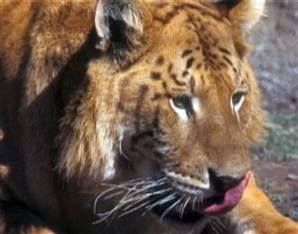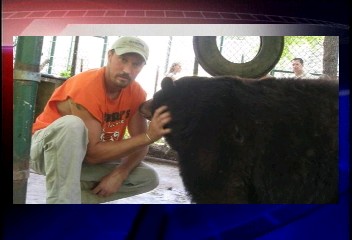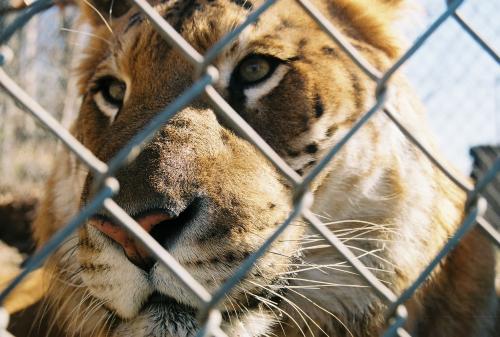Liger Attack Victim Dies
Posted by: Loren Coleman on October 31st, 2008
The animal handler who was attacked by Rocky, a liger, on Wednesday, October 29th, has died.
Zoo volunteer Peter Getz, 32, (shown above, with a bear) died overnight due to severe injuries he sustained in the attack. Getz had been a volunteer at the Broken Arrow, Oklahoma, sanctuary for the past year and a half.
Sanctuary owner Lori Ensign (above) says she’s still trying to piece together what happened but says a policy regarding access to animals during feedings wasn’t followed.
“We try to have all the procedures in place, but for some reason, they weren’t followed this time,” Ensign told NBC affiliate KJRH in Oklahoma. “In all my years, we’ve stressed that whatever you do, you don’t open that gate.”
Ensign says Getz had volunteered at The Safari’s Exotic Wildlife Sanctuary for about a year and a half and previously worked at the Tulsa Zoo.
Ensign said that her sanctuary has closed since the accident. She did not say when it might reopen. She says state wildlife officials are investigating the incident and will decide whether the animal will be euthanized.
The sanctuary is a nonprofit wildlife refuge. All staff members are volunteers. It is licensed and regulated through the Oklahoma Wildlife Department and the U.S. Department of Agriculture and is subject to the same rules as public zoos.
Rocky (above) may have originated in neighboring Texas, which has no laws regarding the keeping and breeding of big cats, speculated the media. The exact number of big cats in Texas is unknown, but estimates have put the population of tigers in that state at between 2,000 and 4,000, which may represent the largest tiger population in the world.
Animal Planet host Jeff Corwin (above) told TODAY’s Matt Lauer that Getz broke the cardinal rule of dealing with large carnivores.
You’re talking about an animal that is 20 times more powerful than the human being that was feeding it. One of the most important protocols with these powerful cats in captivity is to never enter their enclosure with the animal present, especially when it involves food.
This creature could have, by its nature, a very individualistic, nice personality. But the truth is, a tiger that weighs hundreds of pounds only needs to have one bad moment, and one bad moment can be critical, if not lethal, to a human being.
In many situations, the animal is destroyed because it has connected in a negative way and a dangerous way to human beings, and the truth is there’s an increased opportunity for this animal to become even more dangerous.
What it really echoes to is a bigger situation, which is keeping these exotics in captivity for nonlegitimate purposes in the first place. This is a rescue center, but what is the individual history of that liger? How did it get there?
If you went to India today, you would find that there are less tigers living there than there are in the state of Texas, where the laws and regulations are incredibly loose. There are probably 10 people or more that are critically injured [every year], in some cases killed, by tigers, and it’s happening in our own country. – Jeff Corwin, on TODAY
[Thanks to Steve Summar for alerting us to this breaking update.]
About Loren Coleman
Loren Coleman is one of the world’s leading cryptozoologists, some say “the” leading living cryptozoologist. Certainly, he is acknowledged as the current living American researcher and writer who has most popularized cryptozoology in the late 20th and early 21st centuries.
Starting his fieldwork and investigations in 1960, after traveling and trekking extensively in pursuit of cryptozoological mysteries, Coleman began writing to share his experiences in 1969. An honorary member of Ivan T. Sanderson’s Society for the Investigation of the Unexplained in the 1970s, Coleman has been bestowed with similar honorary memberships of the North Idaho College Cryptozoology Club in 1983, and in subsequent years, that of the British Columbia Scientific Cryptozoology Club, CryptoSafari International, and other international organizations. He was also a Life Member and Benefactor of the International Society of Cryptozoology (now-defunct).
Loren Coleman’s daily blog, as a member of the Cryptomundo Team, served as an ongoing avenue of communication for the ever-growing body of cryptozoo news from 2005 through 2013. He returned as an infrequent contributor beginning Halloween week of 2015.
Coleman is the founder in 2003, and current director of the International Cryptozoology Museum in Portland, Maine.















Big Cat Rescue says that this sanctuary at Broken Arrow is not a true sanctuary and that it violates the guidelines for sanctuaries by allowing public interaction with the cats, taking them out on leashes, etc.
I watched several news videos last night where the sanctuary owner, Lori Ensign, was being interviewed about this incident, and I got a very negative impression of her based on those. I got the impression that she was trying to downplay the lack of safety precautions at her facility.
I feel terrible for the man who was killed. I wonder if it will ever be known whether he was in that pen without “permission” or whether that was S.O.P. at that facility.
I find one comment by Jeff Corwin odd. He said :
“What it really echoes to is a bigger situation, which is keeping these exotics in captivity for nonlegitimate purposes in the first place. This is a rescue center, but what is the individual history of that liger? How did it get there?
If you went to India today, you would find that there are less tigers living there than there are in the state of Texas, where the laws and regulations are incredibly loose. There are probably 10 people or more that are critically injured [every year], in some cases killed, by tigers, and it’s happening in our own country.”
I didn’t realize there are ligers in the wild. It’s a liger, not a tiger.
Secondly, while I am not a fan of predators like a tiger or lion in a zoo (simply because you can tell they are meant to have a lot of room to roam), as long as there are poachers and ignorant individuals hunting them, they need all the places to live they can find.
If this was human error, it is a sad story. But it does happen. That in itself does not mean that the entire facility is poorly run. Then again, it could.
Is there any word on the fate of the liger? Will it be put down?
I felt the need to leave a comment here, having had multiple experiences with Lori and the safari sanctuary. I can’t say what these people do/do not do when no one else is around, but my family and I have slept in a cabin just outside the big cat pens from time to time. We often would wake early in the mornings, to watch the cats being fed. The protocol was always.. – always – that the volunteers come no closer to the cats than the walk-between enclosure consisting of two fences. They never at any time opened the enclosures, and the meat was thrown over the fence.
Also, any visitors feeding the cats were given frozen chicken legs, and a pipe. The leg is inserted in one end of the pipe, and inserted through both fences at a height no higher than (I believe) five feet. This was to prevent the cats attempting to scale the fence, if they were to realize that they could indeed climb them.
How affective this method is, I don’t know. It worried me a bit, and the outer fence is only around six feet in height.
I remember Rocky as the massive animal who walked back and forth, rolling bowling balls and in general, appearing gentle and accustomed to human interaction. However, if I remember correctly, this was the same liger who snarled at my husband upon sight. The volunteer informed us that he was kept in a texas apartment as a cub, by a man whom they suspect abused him severely. Therefore, Rocky has an intense hatred of men, particularly those wearing baseball caps and/or sunglasses.
I have met Mr. Getz, and am saddened at his passing. I don’t understand what would possess him to do what he did, as he should have known that even the gentlest creature, as a giant, can do great harm without meaning to. As Lori said, Rocky could break a person’s foot simply by stepping on it.
Again, my intention in posting here was to relay what I have seen of the sanctuary staff. I never saw anyone in all my visits with them, open a gate to feed any of the animals.
This is extremely tragic news. That someone who seemed so dedicated to trying to help these cats should fall victim to one is just shocking. My prayers will go out to him and his family. I know several who knew the man have been following this story here, so to them I offer my sincere condolences.
I am not going to judge the safety precautions of the facility without finding out more hard information, but like I said in the other post, these are not pets. Even captive bred big cats and even other animals such as chimps and elephants are wild animals. No matter how tame they may seem, care must always be exercised and respect shown towards them. To me, it seems that in this case, even that wasn’t enough. That being said, sadly enough, these captive environments are going to likely be the last bastion for the survival of some big cat species. I truly find it sad that this incident is going to bring down so much negative publicity on such establishments and that the cat will likely be destroyed when in the end, it was just being what it is.
That being said, I am against any purposeful breeding of tigers and lions. I tend to frown on intentional creation of hybrids in general (except in a very few special cases), especially between species that would not have the opportunity to do so in the wild. These ligers and tigons often suffer from psychological problems due to sets of parents with such different social structures. In addition, ligers and tigons, indeed hybrids in general, do not always benefit from “hybrid vigor” (enhanced hardiness due to the mix of new genetic material). On the contrary, some hybrids such as ligers can suffer from an increased incidence of certain cancers and other health problems. Ligers, for instance, can suffer from joint and other problems due to their extreme giganticism. It’s sad to me that someone would purposefully experiment around with mixing two species that in this case would not be interbreeding in the wild.
I realize that this sanctuary was not involved with creating this liger, I just thought I would add some thoughts. It is tragic that the people trying to help this cat had to suffer for it.
I can’t say one way or the other whether the safety precautions at this place were adequate; I’ve never been there. I did form an unfavorable impression after watching the news interviews with the owner. I watched those again and my impression is still the same.
Here’s a quote from the Big Cat Rescue blog: “Safari’s Interactive Animal Sanctuary is not a sanctuary, but rather, a part of the problem. Safari’s Interactive Animal Sanctuary at 26881 E 58, east of Broken Arrow, Wagoner County, OK is home to 27 big cats. Former keepers have warned for years that the practices there would lead to injuries, escapes and death. SIAS’ website is covered in the typically ignorant photos of the President, Lori Ensign bottle feeding tigers and walking them on leashes. That kind of irresponsible behavior can only lead to tragedy for humans as well as the animals when they pay the ultimate price. See SanctuaryStandards.com to see that this is no sanctuary.”
I did go to sanctuarystandards.com. The guidelines there clearly state: “Animals shall not be handled in any manner in public view that may portray wild animals as tractable or as pets”.
Yet there are many photos on the The Safari’s Exotic Wildlife Sanctuary’s website of people treating wild animals like pets.
Was this tragic incident a one-time occurrence? Did Peter Getz just sort of coincidentally get fatally attacked the one time that he entered Rocky’s enclosure, alone, while Rocky was feeding? Or was this something that had occurred so frequently at the facility that everyone had sort of let their guard down? There was a group of schoolchildren touring the facility that day … did this happen in their presence? Was Mr. Getz maybe just trying to show them how “tame” Rocky is? These and many other troubling questions surround this tragedy.
As to Rocky himself: Lisa Ensign, in an interview, said “I used to ride Rocky like riding a pony”. So first of all, that means he was her pet … but, why did she stop? Was it because Rocky turned aggressive? Did he, like most big cats, rebel against his human “parents” as he began to reach sexual maturity? In the videos I have seen of Rocky, it’s not clear whether he has been declawed. Declawing is the amputation of the final joint of the cat’s digits (“fingers and toes”). Most people who keep big cats as “pets” have them declawed. Declawed cats often become biters. Declawing also causes arthritic changes in cats’ limbs. The cats develop chronic pain which gets worse as they grow older. Rocky is said to be 12 years old. He has a pronounced limp in his front leg in the videos that I’ve seen. Ligers are so big and heavy that they often develop joint problems. Possibly he lashed out because he was in pain?
Should Rocky be destroyed? In a perfect world, the answer is no. But it’s true that animals who have severely injured their human caretakers often become much more dangerous after that first attack. After they have put a person on the ground and actually injured or killed that person, they realize that they can. Even dogs, with thousands of generations of domestication behind them, often lose their inhibitions about attacking people once they have injured a person in anger. Big cats have no such inhibitions in the first place. Rocky should be very carefully evaluated, and many factors taken into consideration, before the decision is made to destroy him, or not.
My personal opinion is that he should not be destroyed, but he should be permanently taken off public exhibition and retired to a secure facility to live out his days, provided he is not suffering from some medical condition that makes his life painful.
Peter Getz was a friend of mine. I have never met a man who was more passionate about animals… All animals. He truly had a gift and could connect with them on a different level.
I watched him with his bears, tigers, and snakes…it was simply amazing. He had a huge heart and a passion for animal care and education. He made it possible for my Environmental Education Center to have a reptile center and brought me local snakes he had saved from time to time.
My thoughts and prayers are with his family in this tragic time.
Christa Williams
Does anyone know of any updates on this story? What if anything has been done with the liger, I wonder? Are any charges to be filed against the “sanctuary”? The internet appears to be mute on the subject; I haven’t found any updates since the death of Mr. Getz.